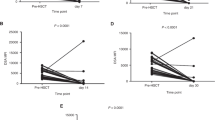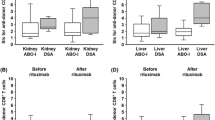Abstract
The engraftment failure associated with Abs to donor-specific HLA (DSA) limits options for sensitized BMT candidates. Fourteen of fifteen patients with no other viable donor options were desensitized and transplanted using a regimen of plasmapheresis and low-dose i.v. Ig modified to accommodate pre-BMT conditioning. DSA levels were assessed by solid-phase immunoassays and cell-based crossmatch tests. DSA levels were monitored throughout desensitization and on day −1 to determine if there was any DSA rebound that would require additional treatment. A mean reduction in DSA level of 64.4% was achieved at the end of desensitization, with a subsequent reduction of 85.5% after transplantation. DSA in 11 patients was reduced to levels considered negative post-BMT, whereas DSA in three patients remained at low levels. All 14 patients achieved donor engraftment by day +60; however, seven patients suffered disease relapses. Four patients experienced mild, grade 1 GVHD. Factors influencing the response to desensitization include initial DSA strength, number, specificity, DSA rebound and a mismatch repeated from a prior transplant. While desensitization should be reserved for patients with limited donor options, careful DSA assessment and monitoring can facilitate successful engraftment after BMT.
This is a preview of subscription content, access via your institution
Access options
Subscribe to this journal
Receive 12 print issues and online access
$259.00 per year
only $21.58 per issue
Buy this article
- Purchase on Springer Link
- Instant access to full article PDF
Prices may be subject to local taxes which are calculated during checkout



Similar content being viewed by others
References
Kekre N, Antin JH . Hematopoietic stem cell transplantation donor sources in the 21st century: choosing the ideal donor when a perfect match does not exist. Blood 2014; 124: 334–343.
Fuchs E, O’Donnell PV, Brunstein CG . Alternative transplant donor sources: Is there any consensus? Curr Opin Oncol 2013; 25: 173–179.
Ciurea SO, Champlin RE . Donor selection in T cell-replete haploidentical hematopoietic stem cell transplantation: knowns, unkowns, and controversies. Biol Blood Marrow Transplant 2013; 19: 180–184.
Cutler C, Ballen KK . Improving outcomes in umbilical cord blood transplantation: state of the art. Blood Rev 2012; 26: 241–246.
Hale GA, Shrestha S, Le-Rademacher J, Burns LJ, Gibson J, Inwards DJ et al. Alternate donor hematopoietic cell transplantation (HCT) in non-Hodgkin lymphoma using lower intensity conditioning: a report from the CIBMTR. Biol Blood Marrow Transplant 2012; 18: 1036–1043.
Luznik L, O’Donnell PV, Symons HJ, Chen AR, Leffell MS, Zahurak M et al. HLA-haploidentical bone marrow transplantation for hematologic malignancies using nonmyeloablative conditioning and high-dose, post-transplantation cyclophosphamide. Biol Blood Marrow Transplant 2008; 14: 641–650.
Kasamon YL, Luznik L, Leffell MS, Kowalski J, Tsai HL, Bolanos-Meade J et al. Nonmyeloablative HLA-haploidentical bone marrow transplantation with high-dose posttransplantation cyclophosphamide: effect of HLA disparity on outcome. Biol Blood Marrow Transplant 2010; 16: 482–489.
Brand A, Doxiadis IN, Roelen DL . On the role of HLA antibodies in hematopoietic stem cell transplantation. Tissue Antigens 2013; 81: 1–11.
Yoshihara S, Maruya E, Taniguchi K, Kaida K, Kato R, Inoue T et al. Risk and prevention of graft failure in patients with preexisting donor-specific HLA antibodies undergoing unmanipulated haploidentical SCT. Bone Marrow Transplant 2012; 47: 508–515.
Fernandez-Vina MA, de Lima M, Ciurea SO . Humoral sensitization matters in CBT outcome. Blood 2011; 118: 6482–6484.
Ciurea SO, Thall PF, Wang X, Wang SA, Hu Y, Cano P et al. Donor-specific anti-HLA Abs and graft failure in matched unrelated donor hematopoietic stem cell transplantation. Blood 2011; 118: 5957–5964.
Fancosi D, Zucca A, Scatena F . The role of anti-HLA antibodies in hematopoietic stem cell transplantation. Biol Blood Marrow Transplant 2011; 17: 1585–1588.
Cutler C, Kim HT, Sun L, Sese D, Glotzbecker B, Armand P et al. Donor-specific anti-HLA antibodies predict outcome in double umbilical cord blood transplantation. Blood 2011; 118: 6691–6697.
Spellman S, Bray R, Ronsen-Bronsen S, Haagenson M, Klein J, Flesh S et al. The detection of donor-directed, HLA-specific alloantibodies in recipients of unrelated hematopoietic cell transplantation is predictive of graft failure. Blood 2010; 115: 2704–2708.
Ciurea SO . High risk of graft failure in patients with anti-HLA antibodies undergoing haploidentical stem-cell transplantation. Transplantation 2009; 88: 1019–1024.
Anasetti C, Amos D, Beatty PG, Appelbaum FR, Bensinger W, Buckner CD et al. Effect of HLA compatibility on engraftment of bone marrow transplants in patients with leukemia or lymphoma. N Engl J Med 1989; 320: 197–204.
Brunstein CG, Noreen H, DeFor TE, Maurer D, Miller JS, Wagner JE . Anti-HLA antibodies in double umbilical cord blood transplantation. Biol Blood Marrow Transplant 2011; 17: 1704–1708.
Ansari M, Uppugunduri CR, Ferrari-Lacraz S, Bittencourt H, Gumy-Pause F, Chalandon Y et al. The clinical relevance of pre-formed anti-HLA and anti-MICA antibodies after cord blood transplantation in children. PLoS ONE 2013; 8: e72141.
Ruggeri A, Rocha V, Masson E, Labopin M, Cunha R, Absi L et al. Impact of donor-specific anti-HLA antibodies on graft failure and survival after reduced intensity conditioning-unrelated cord blood transplantation: a Eurocord, Société Francophone d’Histocompatibilité et d’Immunogénétique (SFHI) and Société Francaise de Greffe de Moelle et de Thérapie Cellulaire (SFGM-TC) analysis. Haematologica 2013; 98: 1154–1160.
Gladstone DE, Zachary AA, Fuchs EJ, Luznik YL, King KE et al. Partially mismatched transplantation and human leukocyte antigen donor-specific antibodies. Biol Blood Marrow Transplant 2013; 19: 647–652.
Costa LJ, Moussa O, Bray RA, Stuart RK . Overcoming HLA-DPB1 donor specific antibody-mediated hematopoietic graft failure. Br J Haematol 2010; 151: 84–109.
Norlander A, Uhlin M, Ringden O, Kumlien G, Hausenberger D, Mattsson J . Immune modulation to prevent antibody-mediated rejection after allogeneic hematopoietic stem cell transplantation. Transplant Immunol 2011; 25: 153–158.
Ishiyama K, Anzai N, Tashima M, Hayashi K, Saji H . Rapid hematopoietic recovery with high levels of DSA in an unmanipulated haploidentical transplant patient. Transplantation 2013; 95: e76–e77.
Zachary AA, Leffell MS . Desensitization for solid organ and hematopoietic stem cell transplantation. Immunol Rev 2014; 258: 183–207.
Montgomery RA, Lonze BE, King KE, Kraus ES, Kucirka LM, Locke JE et al. Desensitization in HLA-incompatible kidney recipients and survival. N Engl J Med 2011; 365: 318–328.
Zachary AA, Lucas DP, Detrick B, Leffell MS . Naturally occurring interference in Luminex assays for HLA-specific antibodies: characteristics and resolution. Hum Immunol 2009; 70: 496–501.
Zachary AA, Sholander JT, Houp JA, Leffell MS . Using real data for a virtual crossmatch. Hum Immunol 2009; 70: 574–579.
Montgomery RA, Zachary AA . Transplanting patients with a positive donor-specific crossmatch: a single center’s perspective. Pediatr Transplant 2004; 8: 535–542.
Alachkar N, Lonze BE, Zachary AA, Holechek MJ, Schillinger K, Cameron AM et al. Infusion of high-dose intravenous immunoglobulin fails to lower the strength of human leukocyte antigen antibodies in highly sensitized patients. Transplantation 2012; 94: 165–171.
Guthoff M, Schmid-Horch B, Wiesel KC, Häring HU, Königsrainer A, Heyne M . Proteasome inhibition by bortezomib: effect on HLA-antibody levels and specificity in sensitized patients awaiting renal allograft transplantation. Transpl Immunol 2012; 26: 171–175.
Everly MJ, Terasaki PI, Trivedi HL . Durability of antibody removal following proteasome inhibitor-based therapy. Transplantation 2012; 93: 572–577.
Philogene MC, Sikorski P, Montgomery RA, Leffell MS, Zachary AA . Differential effect of bortezomib on HLA class I and class II antibody. Transplantation 2014; 98: 660–665.
Zachary AA, Montgomery RA, Leffell MS . Factors associated with and predictive of persistence of donor-specific antibody after treatment with plasmapheresis and intravenous immunoglobulin. Hum Immunol 2005; 66: 364–370.
Locke JE, Zachary AA, Warren DS, Segev DL, Houp JA, Montgomery RA et al. Proinflammatory events are associated with significant increases in breadth and strength of HLA-specific antibody. Am J Transplant 2009; 9: 2136–2139.
Takanashi M, Atsuta Y, Fujiwara K, Kodo H, Kai S, Sato H et al. The impact of anti-HLA antibodies on unrelated cord blood transplantations. Blood 2010; 116: 2839–2846.
Tait BD, Sűsal C, Gebel HM, Nickerson PW, Zachary AA, Claas FH et al. Consensus guidelines on the testing and clinical management issues associated with HLA and non-HLA antibodies in transplantation. Transplantation 2013; 95: 19–47.
Author information
Authors and Affiliations
Corresponding author
Ethics declarations
Competing interests
The authors declare no conflict of interest.
Rights and permissions
About this article
Cite this article
Leffell, M., Jones, R. & Gladstone, D. Donor HLA-specific Abs: to BMT or not to BMT?. Bone Marrow Transplant 50, 751–758 (2015). https://doi.org/10.1038/bmt.2014.331
Received:
Revised:
Accepted:
Published:
Issue Date:
DOI: https://doi.org/10.1038/bmt.2014.331
This article is cited by
-
A Single Centre Experience of Effective Desensitization Strategy for Children with High Anti-HLA Donor-Specific Antibodies Undergoing Haploidentical Hematopoietic Stem Cell Transplantation
Indian Journal of Hematology and Blood Transfusion (2023)
-
Successful allogeneic hematopoietic stem cell transplantation in a patient with type I CD36 deficiency: a case study and literature review
International Journal of Hematology (2023)
-
The impact of HLA donor-specific antibodies on engraftment and the evolving desensitization strategies
Bone Marrow Transplantation (2022)
-
Successful desensitization of high level donor-specific anti-HLA antibody in patients with hematological diseases receiving haploidentical allografts
Annals of Hematology (2022)
-
Depletion of donor-specific anti-HLA A2 alloantibodies in a hematopoietic cell transplant recipient using directed mismatched platelet transfusions
Bone Marrow Transplantation (2018)



